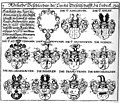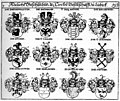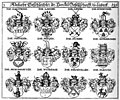Circle society
As a patrician society , the circle society was an association of the urban patriciate in Lübeck .
History and meaning
The official name of the brotherhood of long-distance trade merchants founded on September 2, 1379 was Society of the Holy Trinity in Lübeck . Because of its symbol, an open circle in a circle slightly open at the bottom - a symbol of the Trinity - it was generally called a circle society or circle company . Later it was also known as the Junker Company . In this context, the term Junker refers to younger male members of families who are capable of being advised. The cohesion of the leading families , mostly from Westphalia , has been close since the city was founded; the historian Philippe Dollinger refers to a letter from 1380, according to which the majority of the council members were related at least in the 3rd degree.
The society combined religious with representative and political motives. The founding deed was in itself a contract for the brotherhood of prayer between the founders and the Franciscans at St. Katharinen: nine people, Boldewin Speygeler, the brothers Gerd and Hermann Darsow , the brothers Heinrich and Johann Meteler, Marquard von Dame , Jacob Holk , Hermann More or Morum and Arnd von der Bruges, sign a contract with the monks of St. Catherine's Monastery , who let them have a chapel in their then new monastery church . In the contract, the monks undertake to read mass every day for these nine people and for all future members of their society and brotherhood, on Sundays immediately after the sermon, on weekdays after the other masses have ended. They accept them into the community of all their good works and undertake to perform all the prayers and other good works that they are customary to do for the brethren of their own monastery for the salvation of his soul when a member dies. The Lübeck Carnival Games played a major role in the company's external image .
According to Luebian law , it was one of the merchant corporations represented in the city council , from which the council made up its own staff. In fact, for centuries - especially in view of its small number of members in relation to the other corporations - it was strongly disproportionately represented in the council and provided the majority of Lübeck's mayors . From its inception until about Kassarezess (except for the years 1408-1416, in which the Company due to a temporary shift in power in fact did not exist; only in 1429 she received new statutes) placed them due to this influence the actual social power center of Lübeck thalassocracy is to who also transferred merchants from other corporations as soon as they were asked.

After the company was reconstituted in 1429, the mayor Hinrich Castorp changed course in the second half of the 15th century from a pure union of successful long-distance trade merchants to representing the interests of the Lübeck patriciate, which has now emerged . In 1483 only one councilor did not belong to this society. At this time, the successful founding families of Lübeck began to copy the lifestyle of the surrounding aristocracy , to acquire agricultural property and to live on pensions from bonds and property. From this layer, the members of this most distinguished merchant corporation in Lübeck were recruited from now on, always in addition to successful newcomers.
In 1485, the circle society received an imperial privilege that allowed its members to wear the society's mark on a gold chain ( collar ) in public. In this way, this bourgeois society was equated with aristocratic circles and orders.
After reaching the height of its social power in the 15th century, society lost its influence in the 16th century. During the unrest of the Wullenwever time, her house on Königstrasse was looted and destroyed in July 1531. Like most other societies, the circle company also died. In 1580 it was re-founded as an association of long-established families under Joachim Lüneburg .

With a patent dated October 9, 1641, Emperor Ferdinand III confirmed . the privileges of the circle society and at the same time recognized the nobility of the Warendorp , Wickede , Brömbsen , Lüneburg , Kerkring , and Stiten families that belonged to it at that time . At the same time, the company tightened its admission requirements. This secured its exclusivity in the short term, but in the long term led to the society losing more and more members and influence. The imperial mediated citizen recession also confirmed the circle society as Lübeck's constitutional body, but clearly limited further influence in the council. In the 18th century only the Brömbsen and Wickede families and families into which their female members had married remained. The last member was Friedrich Adolph von Heintze in 1805 . The last active member died in 1820. Subsequently, the society was dissolved.
Society house
In the beginning the society rented houses for their winter get-togethers. In 1479 she acquired the house at Königstrasse 21, which soon became a center of social life in the city. The summer events took place in the Olafsburg , a kind of moated castle on the Wakenitz between the Hüxtertor and the Mühlentor , and later also on the manor house in Groß Steinrade , which was decorated with paintings on the history of the circle society. Looted and devastated during the unrest of the Reformation, the house on Königstrasse was not used between 1538 and 1580, then renovated between 1581 and 1584 after the restoration of society. From 1776 to 1779, it was renewed and expanded in the plait style based on ideas from Friedrich Bernhard von Wickede . After the company was dissolved, the house came into the possession of the city, which made it available to the Higher Appeal Court of the four Free Cities . After that it was first used by the Lübeck State Archives , later as a public library and as a branch of the Katharineum . Today it houses the Willy Brandt House Lübeck of the non-partisan Federal Chancellor Willy Brandt Foundation .
Chapel and brotherhood altar

Since the fraternization agreement with the Franciscans of 1379, the society had a richly furnished side chapel in the westernmost yoke of the north aisle of the Katharinenkirche . The winged altar donated for the chapel in 1430, as evidenced by the coats of arms of the Meteler, von Wickede, Brömse and von Rentelen families, came to the Georgskapelle (Bad Schwartau) at the beginning of the 17th century . From 1841 to 1901 it was kept in the Schwartau administrative building because the chapel was used for other purposes. From 1901 to 1926 he was again in the Georgskapelle. The altar, also known as the Schwartauer Altar, has been in the St. Annen Museum since 1926 , to which it was given in 1937. The older middle section (around 1405), consisting of a relief made of Baumberger sandstone , and the painted wings come from various artists whose names have not survived.
The side chapel, which, after long neglect, was repaired by the Society for the annual celebration of Trinity in 1760 and also repainted on this occasion, was closed with a three-sided barrier system dated 1458, which reached into the central nave. It was removed in 1947 as part of the reorganization of the interior of the Katharinenkirche to make room for the installation of the cast of the St. Jürgen group by Bernt Notke . Since then, "the oldest firmly datable chapel closure from a Lübeck church" has been stored in the warehouse of the St. Anne's Museum.
Members and member families
See the list of members of the circle society
- Coats of arms of the families belonging to the circle society (1703)
literature
- Sonja Dünnebeil: The Lübeck Circle Society. Forms of self-portrayal of an urban upper class (publications on the history of the Hanseatic city of Lübeck, published by the archive of the Hanseatic city, series B, volume 27) Lübeck: Schmidt-Römhild 1996. ISBN 3-7950-0465-9
- Sonja Dünnebeil: On the importance of the circle society in the 15th century , in: Contributions to the social history of Lübeck upper classes in the late Middle Ages. Lectures at a working session on July 14, 2000 in Kiel, ed. von Harm von Seggern and Gerhard Fouquet (online publications of the Kiel Professorship for Economic and Social History 1), Kiel 2005, pp. 17–39 ( PDF )
- Rafael Ehrhardt: Family and Memoria in the City. A case study on Lübeck in the late Middle Ages. Dissertation, Göttingen 2001. With a prosopography of the council families von Alen, Darsow, Geverdes, Segeberg and Warendorf. ( PDF, 8.54 MB )
- About the circle brothers altar: Uwe Albrecht (Hg.): Corpus of medieval wood sculpture and panel painting in Schleswig-Holstein, Volume I: Hanseatic City of Lübeck, St. Annen Museum . Kiel: Ludwig, 2005. ISBN 3933598753 , pp. 123–129
- Rudolf Struck : On the knowledge of families in Lübeck and their relationships to local and foreign art monuments in: Museum for Art and Cultural History in Lübeck. Yearbook 1914 • 1915 (Volume II. – III.), HG Rahtgens, Lübeck 1915, p. 41–73 (p. 64 ff .: III. The von Rentelen, the glass paintings of the castle church and the altar shrine of the infirmary chapel in Schwartau )
- Carl Friedrich Wehrmann : The Lübeck patriciate. In: Journal of the Association for Lübeckische Geschichte und Altertumskunde 5 (1888), pp. 293–392.
- Wilhelm Brehmer : Directory of the members of the circle company together with information about their personal circumstances. In: ZVLGA 5 (1888) ( digitized version), pp. 393–454
Web links
Sources and Notes
- ^ Philippe Dollinger: The Hanseatic League. 2nd edition, Stuttgart 1966, p. 179 ff.
- ↑ According to Wehrmann (lit.), p. 293f.
- ↑ Eckehard Simon: Organizing and Staging Carnival Plays in Late Medieval Lübeck: A New Look at the Archival Record. IN: The Journal of English and Germanic Philology 92 (1993), pp. 57-72 ( JSTOR 27710764 )
- ^ Hermann Mitgau , Göttingen, mentioned in his lecture "Closed marriage circles of social inbreeding", published in: Deutsches Patriziat 1430-1740, Büdinger lectures 1965 (writings on the problems of the German leadership classes in modern times, volume 3 of the complete series, on behalf of the Ranke Society, Association for History in Public Life, published by Hellmuth Rössler ), CA Starke Verlag Limburg / Lahn 1968, pp. 1–25, here p. 16 f .: "[...] That is the study by Wegemann on the leading families of Lübeck and their partnerships. It is limited to 77 old Lübeck families that made history, that is, Hanseatic-Lübeck history, almost a classic example of the inbreeding of the sexes capable of being advised. The age of self-assertion is surprising all old families have disappeared, but how long have some held their ground! The Warendorp, extinguished in Lübeck in 1714, seated on the council for 383 years, from 1183 to 1566 , with 14 councilors and six mayors. The von Stiten with twelve councilors and three mayors until 1692, 245 years in the council. The Brömse with 15 councilors and five mayors until 1800, 331 years on the council, until 1744 the Lüneburg, one of the oldest families of outstanding duration, 451 years in the council with 15 councilors, five mayors. Only the Wickede, which went out in 1776 and are 450 years old since 1326, have a verifiable rate with 15 councilors and six mayors. And then the new sexes include the Kerkring, who have been a councilor for 321 years with 14 councilors and two mayors. In 1810 the Rodde disappeared, who had had ten councilors and six mayors since 1612. They all belonged almost exclusively to the exclusive circle society, whose Junkers had been on an equal footing with the lower nobility since 1641, and here again primarily to the circle of the so-called clerical families. There are large merchant and landowner families. In 1810 [...] the circle society then goes out: It is not one of the old families that is not part of this circle. When the revolution brought the rule of the families to an end in 1848, these old families were no longer represented in Lübeck. (A supplement to this publication, which appeared in 1941, is a student work by Käte Godbersen on the Wickede, who are represented in the circle society by their names . It results in a closed marriage circle of these old Lübeck patricians.) [...] "
- ↑ Wehrmann (lit.), p. 360.
- ↑ Mayor Christian Nicolaus von Evers died as the last surviving member ever in 1869
- ↑ See also Dünnebeil (lit.), p. 84 (about Olafsburg) and 173 (Groß Steinrade)
- ↑ Johannes Warncke: The house of the circle company to Lübeck , in: ZLG Volume 27 (1934), pp. 239-261.
- ↑ All of these had also contributed to the reconstitution of society
- ^ Brigitte Heise / Hildegard Vogler: The altars of the St. Annen Museum. Lübeck 1993, p. 19ff.
- ↑ Wehrmann (lit.), p. 367: The chapel, which has not been used for centuries, has long served as a storage place for building materials; it had to be cleaned and repaired. This happened, however, and in order to show the purpose of the chapel to the whole world, the inscription was placed on the western wall facing the street: FRIEDERICUS III, ROME. IMPERATOR, collegium confirmavit Anno 1485, and underneath a picture of the emperor painted. The opposite wall received the inscription: Locus conventionis sacer, and below it in a shield the symbol of the company and around the shield the chain .
- ↑ See the photo by Wilhelm Castelli from 1937 in: Thorsten Albrecht: Lübeck - black and white: Photo specialist Wilhelm Castelli 1901–1984. Accompanying publication to the exhibition from January 20, 2002 to May 5, 2002 in the Museum for Art and Cultural History of the Hanseatic City of Lübeck, ( Behnhaus ). Lübeck 2002, p. 67 Fig. 39
- ↑ Description by Uwe Albrecht (ed.): Corpus of medieval wooden sculpture and panel painting in Schleswig-Holstein , Volume I: Hanseatic City of Lübeck, St. Annen Museum. Kiel: Ludwig, 2005. ISBN 3933598753 , pp. 220f












